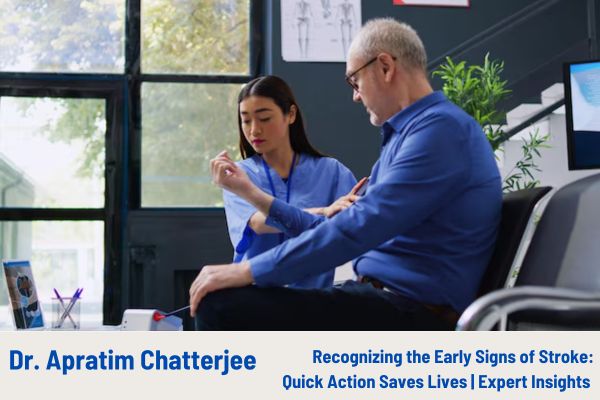Recognizing the Early Signs of a Stroke: How Quick Action Can Save Lives with Dr. Apratim Chatterjee
Strokes are one of the leading causes of disability and death worldwide, but did you know that acting quickly when symptoms appear can dramatically improve the outcome? Dr. Apratim Chatterjee, an expert in neurology, emphasizes that recognizing the early signs of a stroke can be life-saving.
In this blog, we’ll explore the crucial signs and symptoms of a stroke, why immediate action is so important, and how you can make a difference in someone’s life by responding quickly.
What is a Stroke?
A stroke occurs when there’s an interruption of blood flow to the brain, causing brain cells to become damaged or die. There are two types of strokes: ischemic (caused by a blocked artery) and hemorrhagic (caused by a ruptured blood vessel). While strokes can happen suddenly, early intervention can significantly reduce brain damage and long-term disability.
Recognizing the Early Signs of a Stroke
According to Dr. Apratim Chatterjee, stroke symptoms often appear suddenly and require immediate attention. Here are the most common early signs:
- Sudden Numbness or Weakness – This usually affects one side of the body, often in the face, arm, or leg. If someone feels numbness or weakness suddenly, especially if it’s localized to one side, it could be a sign of a stroke.
- Confusion or Difficulty Speaking – A person experiencing a stroke may struggle with speaking, understanding, or slurring their words. If someone suddenly finds it hard to communicate or understand what’s being said, it’s a clear warning sign.
- Visual Disturbances – A sudden loss of vision in one or both eyes or blurred vision can be associated with a stroke. If this happens, immediate medical attention is necessary.
- Severe Headache – A sudden, severe headache without any known cause, especially if accompanied by other symptoms, could indicate a stroke. This is particularly true if the headache is sudden and different from usual headaches.
- Dizziness or Loss of Balance – Difficulty walking, dizziness, or sudden loss of coordination are symptoms that may indicate a stroke, especially when combined with other warning signs.
Why Time Matters in Stroke Treatment
Every minute counts when it comes to treating a stroke. Dr. Apratim Chatterjee stresses that the quicker you seek medical help, the higher the chance of reducing brain damage and improving recovery. The first few hours after the onset of symptoms are critical.
When a stroke occurs, brain cells begin to die due to the lack of oxygen. The longer the brain is without blood flow, the greater the risk of permanent damage. Immediate medical intervention can restore blood flow to the brain and minimize brain damage.
What Should You Do if You Suspect a Stroke?
Dr. Chatterjee advises the following steps if you or someone else shows signs of a stroke:
- Call Emergency Services Immediately: Don’t wait! Call your local emergency number to get immediate medical assistance.
- Use the FAST Method to Assess Stroke Symptoms:
- F – Face: Ask the person to smile. Does one side of the face droop or appear uneven?
- A – Arms: Ask the person to raise both arms. Does one arm drift downward?
- S – Speech: Ask the person to repeat a simple sentence. Is their speech slurred or jumbled?
- T – Time: If you notice any of these signs, call emergency services immediately. Time is critical in preventing brain damage.
The Role of Medical Professionals in Stroke Treatment
When you reach the hospital, medical professionals will quickly assess the situation and work to restore blood flow to the brain. Depending on the type of stroke, treatment options may include clot-busting medication, surgical intervention, or other specialized therapies.
Dr. Apratim Chatterjee emphasizes that rapid intervention within the first few hours of a stroke can make a significant difference in the patient’s long-term health and recovery.
Preventing a Stroke: Tips from Dr. Apratim Chatterjee
While strokes can happen unexpectedly, there are steps you can take to reduce your risk:
- Maintain a healthy blood pressure: High blood pressure is a leading cause of stroke. Regularly monitor your blood pressure and take necessary steps to keep it in check.
- Quit smoking: Smoking increases your risk of stroke by contributing to the hardening of the arteries.
- Eat a balanced diet: A healthy diet that’s low in fat, salt, and cholesterol can help keep your heart and blood vessels in good condition.
- Exercise regularly: Staying active helps improve circulation and reduces your stroke risk.
- Control diabetes: If you have diabetes, manage it carefully to avoid complications that could increase stroke risk.
Final Thoughts
Recognizing the early signs of a stroke and acting quickly can make a huge difference in saving lives and reducing long-term disability. Dr. Apratim Chatterjee’s advice emphasizes the importance of acting fast and getting medical help immediately.
By learning the warning signs and the FAST method, you can help prevent irreversible damage and improve recovery chances for yourself or others.

